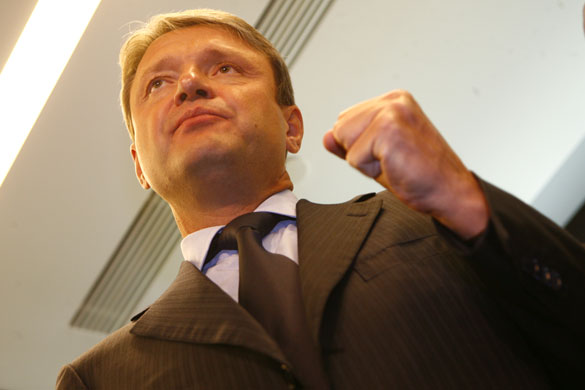
Moscow Weighs Various Options for Stabilizing Stavropol
Publication: Eurasia Daily Monitor Volume: 10 Issue: 34
By:

At the start of 2013, Russian media increased their coverage of a possible demographic shift in Stavropol region in favor of North Caucasians. The Stavropol region is the largest territory in the North Caucasian Federal District, with a population of 2.8 million, which is just a little less than in Dagestan. Nearly two-thirds of the ethnic Russians who live in the North Caucasus Federal District—about 2.3 million people—reside in Stavropol region (www.stavregion.ru/_/cms_page_media/1246/perepis2010.pdf). Ethnic Russians comprise almost 81 percent of Stavropol region’s total population (https://www.stavregion.ru/stat/social/religion/). Around 150,000 North Caucasians live in the Stavropol region.
One would think that with such a favorable ratio, Russians should not be frightened of the North Caucasians. However, it is the dynamic of the demographic processes that apparently troubles Moscow the most. The Russian population of Stavropol region has been stagnant over the past decade. In 2002, there were 2,231,759 ethnic Russians living in the region and by 2010 they numbered 2,232,153, so the population of ethnic Russians increased by only 394 people during those entire eight years (https://www.gks.ru/free_doc/new_site/perepis2010/croc/results2.html). During the same period, all the North Caucasian ethnic groups living in Stavropol region grew in size except for the Chechens, whose population decreased by over 1,000 people. Thus, the ethnic Russian portion of the Stavropol region’s total population dropped by two percent in this period (https://russkazka.wordpress.com/2013/02/06/stavropol-5/).
Given the fact that more than two million ethnic Russians live in Stavropol region, a two-percent decrease would not matter that much if the North Caucasians were dispersed evenly across its territory. However, the non-ethnic Russians live in the southern areas of Stavropol region, adjacent to the republics of the North Caucasus. This tendency is particularly marked in the areas near Dagestan, where ethnic Dargins and Avars live. The Neftekumsky and Kurskoy districts of Stavropol region are especially open to non-Russian settlers. Neftekumsky district has a long border with Dagestan, while Kurskoy district borders Dagestan, Chechnya, North Ossetia and Kabardino-Balkaria (https://rodrus.com/news/news_1339161480.html). Chechens tend to reside in Kurskoy district, while Avars live in Levokumsky district, which is also close to Dagestan. The ratio of non-Russians to ethnic Russians in Kurskoy district is already 50/50. Andropovsky district is home to many Dargins, while Karachays reside in the area around Pyatigorsk and so on. During the first nine months of 2011, an estimated 1,600 ethnic Russians abandoned the eastern parts of Stavropol region alone in a startling change to the regional demographic development (https://www.youtube.com/watch?feature=player_embedded&v=1lkVgdRfq8I#).
Why did people start to raise the issue of Stavropol’s demographics now? In fact, the governor of Krasnodar region, Alexander Tkachyov, triggered the debate. He publicly stated that he used to think of Stavropol region as a barrier between Krasnodar region and the North Caucasus, but Stavropol region had become so full of North Caucasians that it was high time for his region to restrict the inflow of North Caucasians (www.yuga.ru/articles/society/6390.html). Tkachyov did not arrive at this conclusion on his own: prior to his sensationalist statement there had been a backlash from the Russian Orthodox Church. Metropolitan Kirill of Stavropol and Nevinnomyssk, who is chairman of the Synodal Department for Cooperation with the Cossacks, sounded the alarm over the ethnic Russians in Stavropol region. Kirill said that North Caucasians “often behave very aggressively, forcing Russians to leave their land” even though “Russians and Caucasian peoples lived together fairly peacefully for centuries.” The clergyman emphasized that people needed “to learn the culture of coexistence again.” He was especially concerned about the situation in the eastern part of the region, where he claimed there are “terror attacks and Wahhabism” (https://newsland.com/news/detail/id/914664/).
After Kirill’s statements, the public discourse shifted to equating the future of Stavropol region to the events in Kosovo and Yugoslavia (https://3rm.info/27132-stavropole-prevratitsya-v-kosovo.html). Thus, under such pressure from both Russian and North Caucasian nationalists, ordinary Russians feel uncomfortable and are simply heading north, to Voronezh and other regions (https://mokrousov-s.livejournal.com/45673.html). The idea of relocating Cossacks from other regions to Stavropol also has begun to be discussed as a means of stopping the exodus of ethnic Russians from the region. At a meeting of the council on inter-ethnic relations, Stavropol Governor Valery Zerenkov announced plans to resettle Cossack settlers from Kyrgyzstan and Kazakhstan (https://lenta.ru/articles/2012/12/06/sevenrivers/). So far only 2,000 Cossack families have agreed to resettle, and they will be accommodated not in the eastern districts of Stavropol region, but near the city of Stavropol, which makes their resettlement of little utility for the authorities, who are particularly worried about the east. If, however, the Semirechensk Cossacks in Kyrgyzstan and Kazakhstan decided to move en masse, they would add several tens of thousands to the Russian population of Stavropol region.
Tensions in the Stavropol region have led to numerous fistfights, which are immediately portrayed as inter-ethnic conflicts even when they have nothing to do with ethnic tensions per se (https://kavpolit.com/stavropol-gorod-kresta-i-polumesyaca/).
People in Stavropol region are frightened less of the North Caucasians themselves as they are of their religion. The North Caucasus highlanders arrive in Stavropol region with their mosques and their culture based on Islam. For example, a scandal erupted in Stavropol region when Dagestani children demanded they should be able to wear the hijab to school. The principal of a school in the Nogai-populated village of Kara-Tube banned several pupils from attending the school for wearing the hijab. The parents then complained that their children were being persecuted for following Islamic canons (https://top.rbc.ru/society/15/10/2012/674341.html). Regional authorities in Stavropol region are trying to contain the spread of Islam and migration from the North Caucasus, but their efforts are proving to be ineffective (https://kavpolit.com/ryba-gniyot-s-golovy-no-chistyat-eyo-s-xvosta/).
Consequently, Cossacks in the Stavropol region already think a demographic shift has started that could transform this ethnic Russian region into a majority non-Russian territory. Stavropol region was historically founded as a Russian-populated area after the Russian Empire carved it out of the North Caucasus. The Russian Orthodox Church and the authorities have found common ground on this issue and intend to defend the lands of the Stavropol Cossacks. However, the North Caucasians do not plan on backing down, and their natural drift to the north is projected only to grow over time. Thus, against the backdrop of multiple issues in the North Caucasus, the Stavropol region could become an additional factor of instability in the region, moving from a Russian island in a sea of Muslim peoples to a regional flashpoint. One option available to Moscow to offset this development would be for federal authorities to review the borders of the North Caucasus Federal District and make it more Russian by including Krasnodar and Rostov regions in it, thereby rendering the North Caucasians a minority within the district.




